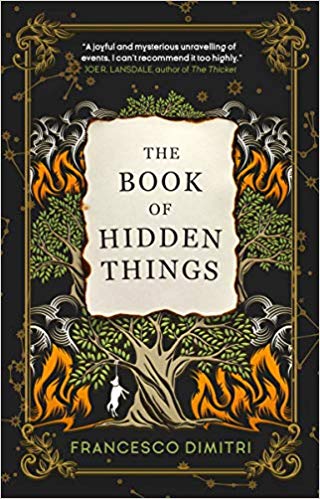The Book of Hidden Things – Francesco Dimitri

I read this book during the early part of last summer. According to the blurb ‘From “one of the most significant figures of the last generation of fantasy”, comes Francesco Dimitri’s debut novel in English, an enthralling and seductive fantasy following four old friends and the secrets they keep’ (just to clarify, the quotation marks in the middle of that excerpt are nothing to do with Tomeopathy).
Let us start by stating straight up that this book is definitely not a fantasy novel, magical realism? Possibly. Slightly occult? Yes. Fantasy? Definitely not. Based on the blurb, Tomeopathy picked up this book expecting something similar to John Connelly’s The Book of Lost Things (an excellent read and absolutely a fantasy book); the similarity in content diverges after the second word of the titles.
However, that does not make The Book of Hidden Things a bad book, far from it, and it would be unfair to suggest that there are no fantastical elements in the story. There is an underlying thread of a fantasy, but where a fantasy book would follow the character through the wardrobe and into Narnia, this is told from the sceptical perspective of the characters who never made it to Narnia.
The book is set in a small village in Southern Italy, it’s the kind of idyllic sleepy backwater that is heaven for tourists and therefore thriving in holiday season but quiet outside of that. In short, the type of place teenagers cannot wait to leave behind, which is exactly what three of the four central characters have done. The story begins in a small restaurant, the subject of a pact between those four, now much older, friends which states all of them will gather there on the same day each year no matter what. This year for the first time, a member of the group fails to attend. Art is the mercurial member of the group and the local, so the others decide to drop by and check in on him. When they can’t find him, they begin to worry, particularly as Art went missing for several weeks when they were teenagers, an event which was never explained to the satisfaction of his friends. The remainder of the book concerns itself with the search for Art, an activity that leaves plenty of space for the friends to reminisce and explore the repercussions of that disappearance and the lasting effects it had on their lives.
The fantastical strays into this book because of Art’s original disappearance, there is a supernatural element to his inconsistent explanations, which the remaining friends struggle to accept. It bubbles along under the surface, sometimes present and at others completely absent from the book before resurfacing later on. As a device to keep me intrigued it served its purpose, but it wasn’t necessary, I’d have continued reading based on the strength story regardless, and it never fully materialises. The real hook of this book is the exploration of abiding friendship, the carefully observed unravelling of long held assumptions, the unspoken resentments, and the continuous redrawing of boundaries of favour. The bittersweet relationship between the characters and the setting manifests powerfully throughout the book and contributes no end to the empathy felt for the protagonists.
I would recommend this book highly, especially for a holiday read, there’s intrigue aplenty to keep you from snoozing off on the sun lounger. Just don’t expect it to be a fantasy!